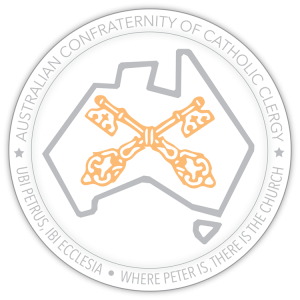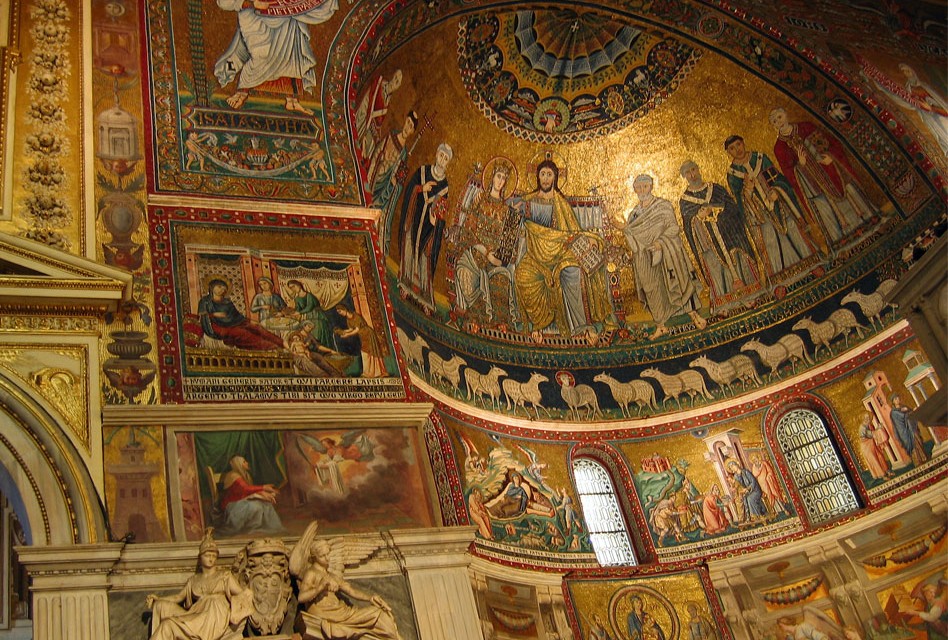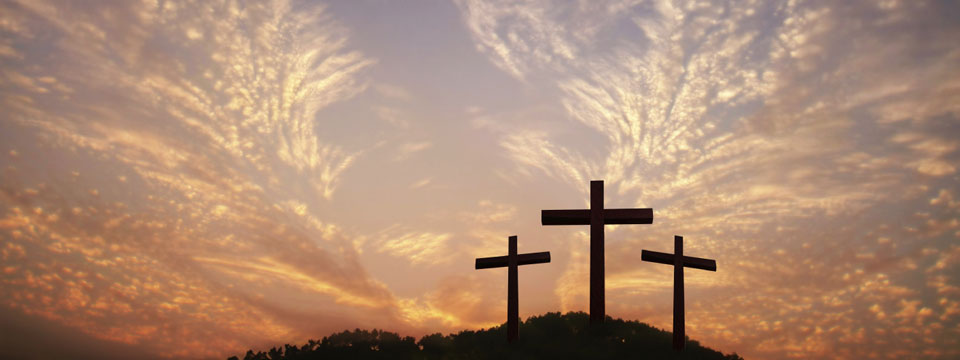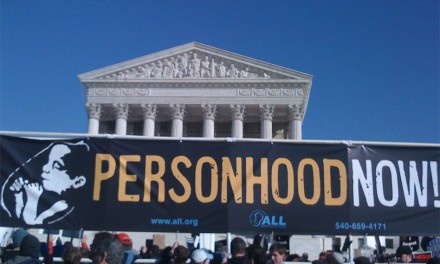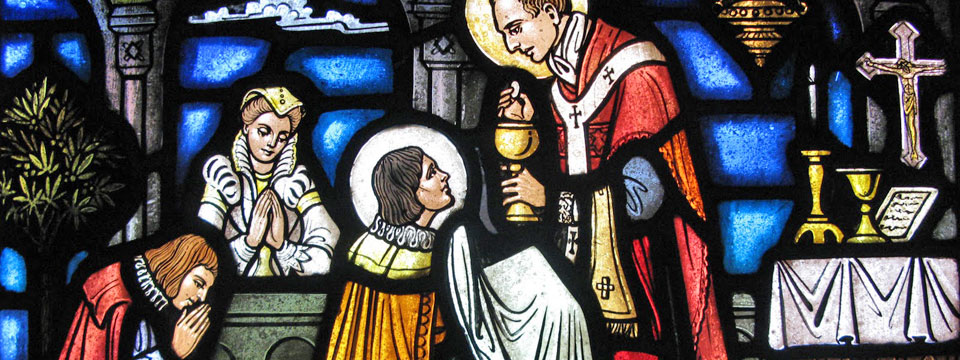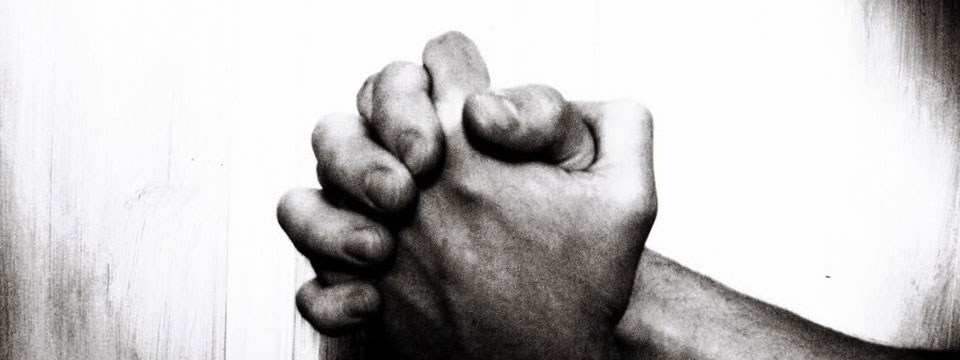It is fitting that we gather as priests from across the Anglophone world to pray and confect the Eucharist together in the ancient Church of Santa Maria in Trastevere. Its origins are obscure, but certainly very early. Tradition claims that this was the first church in Rome where Mass was celebrated openly, rather than in house churches which were used predominantly for about 300 years.
Print Friendly Format
Download and view this article as it appeared in the Winter 2015 issue of The Priest.
Pope Julius I (337 – 52) certainly built a Basilica “trans Tiberim”, on the wrong side of the river Tiber, close to or within the Jewish quarter. The Church might have been built a century earlier, soon after the death of Pope Callistus in 222, a slave (and rival to Hippolytus), who was martyred nearby. Other legends speak of an even earlier Christian house church and a pagan shrine around or next to a fountain of oil.
The Church as we have it, with the beautiful mosaics, which were already more Western than Byzantine, dates from the twelfth century as does the bell tower and the Cosmati floor tiles. The columns in the nave are much more ancient, certainly carved from Egyptian stone and possibly quarried from the Baths of Caracalla. Many of the capitals are different and one thesis is that they were taken from earlier pagan temples, which would be the type of enculturation we all approve!
I stayed nearby off and on in the Palazzo San Calisto for nearly 20 years and liked to come here and pray, secure in the tradition of more than 1750 years of prayer and worship in this place. It is a sacred space, a house of God. Incidentally it was a titular church of Henry Cardinal Duke of York whom the Jacobites recognized as Henry IX of England and Henry I of Scotland.
We celebrate the Mass today of Christ the High Priest and the gospel reminds us, quoting from the Old Testament Prophet Isaiah, of the difference Christ’s coming has made. As the pagan darkness advances here and there around us, we must never forget what a great light Christ is in every land of shadows. Christ’s life and teaching show us what the good God himself is like. Christ has brought God down to our level, which makes our worship so much easier than it was for the Jews who had no such human bridge to the Transcendent.
The title of High Priest is taken over from the Jews with their High Priest in Jerusalem, and the Romans had an office of High Priest, which Julius Caesar apportioned to himself, the first Roman leader to do so. With Augustus it became a regular imperial title. In this context the English word “priest” comes from the Greek “hiereus” and the Latin terms “sacerdos” – touching on the sacred and “pontifex”, pontem facere, a bridge builder between God and man, representing God to man and man to God. Jesus is the only and eternal High Priest, our unique redeemer and mediator. Public atheists such as the late Christopher Hitchens and Richard Dawkins have been busy during the last few years, despite the fact that the intellectual case for a Creator God has never been stronger.
The world came to be either through blind purposeless chance or through an extraordinary act of directive Intelligence. Scientists now have some good idea of the fine tuning necessary for life to exist on a planet and indeed for the universe to exist at all! If any one of the four fundamental forces of the universe – gravity, the electromagnetic force and strong and weak nuclear forces was altered, the universe could not exist. If any ratio between the nuclear strong force and the electromagnetic force had been off by even one part in 100,000,000,000,000,000, then not one star cloud have been formed!
I recently heard of a year twelve class in a Catholic school in Australia where thirty per cent of the students claimed to be atheists. We need to be regularly active making the intellectual case for God, especially to the young. This is part of the struggle between the two standards, God and the world; not simply between good and evil, but between belief and unbelief, monotheism or some pale alternative; between Christ and the anti-Christ, between the Children of God and children of the world.
I believe the Old Testament Prophet Elijah is a suitable patron for us today — not because he slaughtered the 450 priests of Baal (they were not then into inter–religious dialogue!) — but because he saved the monotheistic tradition from extinction against King Ahab and his even more formidable wife Jezebel. I find the New Testament question “When the Son of Man comes will be find faith on earth?” probably the most disturbing lines in the Scriptures. We must work hard to slow and reverse the draft to unbelief in our generation. Naturally we preach the goodness and reality of God through lives of effective service inspired by love, but we should also strive, as the builders of this Church did, to provoke and deepen an awareness of the Transcendent, strengthen the sense of the sacred in our Churches.
Here the ancient altar is a dozen or so steps above the level of the nave to emphasise the difference between the day to day prayers of the faithful and what occurs in the celebration of the Eucharist. The altar itself is covered or encased in an ancient baldachino (like the altar at St Peter’s) which mirrors the tent held above the bride and groom in a Jewish wedding ceremony. Here we are reminded of the marriage between Christ and his people.
We are told that for most of the first millennium Western churches had a veil between the body of the Church and the altar, which was opened at some times during Mass — e.g. the consecration. This survives in the Eastern ikonostasis and our remaining altar rails. All to remind us of the reality of the sacred. Undoubtedly we have gone too in removing the reminders, the defences of the sacred in our liturgies. And I repeat, as I have on a member of other occasion, that in some future reform of the liturgical reform, it will once again become the norm for the priest to face East during the Eucharistic prayer (not during the introduction nor the readings) with his back to the people. No clearer piece of evidence could demonstrate that the human celebrant should not be the focus of the Eucharistic act of worship.
Jesus forgave sins and cured those suffering from diseases of soul, mind and body; the possessed, epileptics and paralysed. So does the Church today through her ministers and members. How weakened society will become as this tradition weakens. I urge you to present the future to our young believers in its inevitable and inescapable logic. Tell them that unless some of them step forth into Catholic leadership as priests, catechists, teachers, religious, members of the new movements etc., then the Church must wither and decline. God always calls enough men to the priesthood, sufficient leaders to service. The problem is that we are listening on, or tuned into, different wavelengths; perhaps we find too much static on the line. It is good to urge older Catholics to pray for vocations; but it is even better to urge the young people to pray for this and confront them with the future.
I repeat my expression of gratitude and admiration for your work as priests; sometimes a hard slog in spiritual or societal or even geographic isolation. May God bless and reward your work and may you be rewarded, as promised, one hundred fold in this life; and with eternal life in the next.
